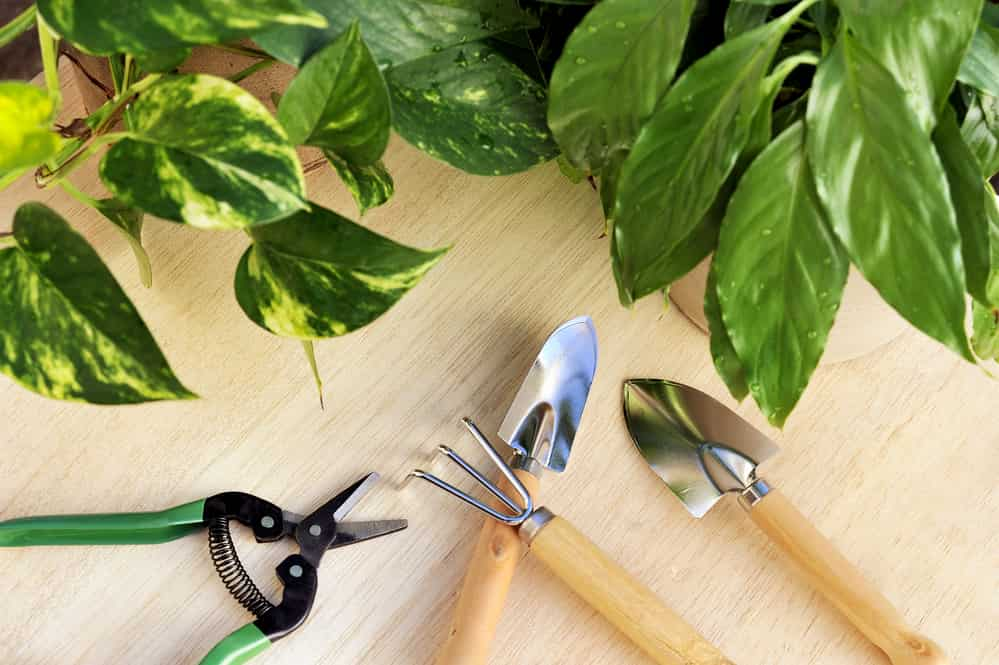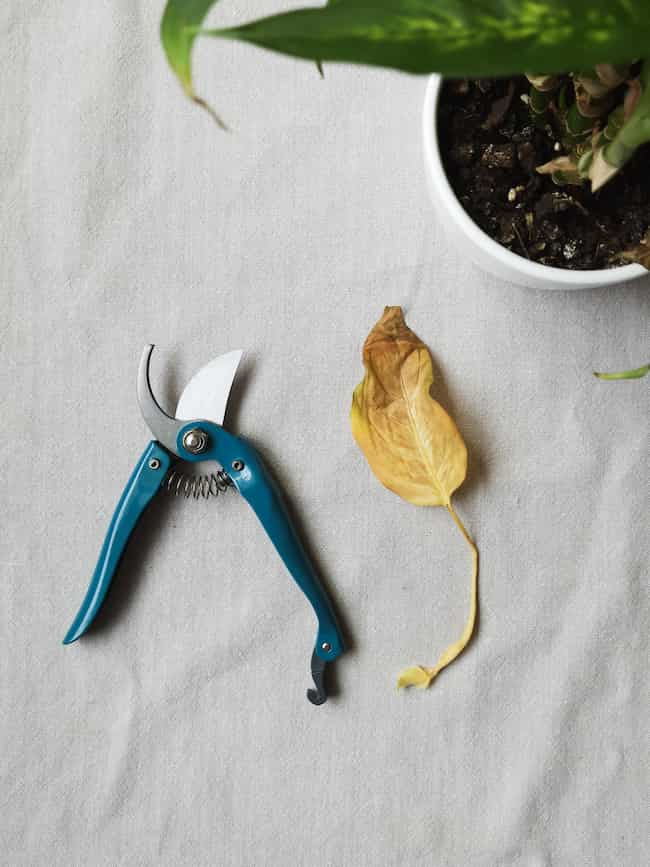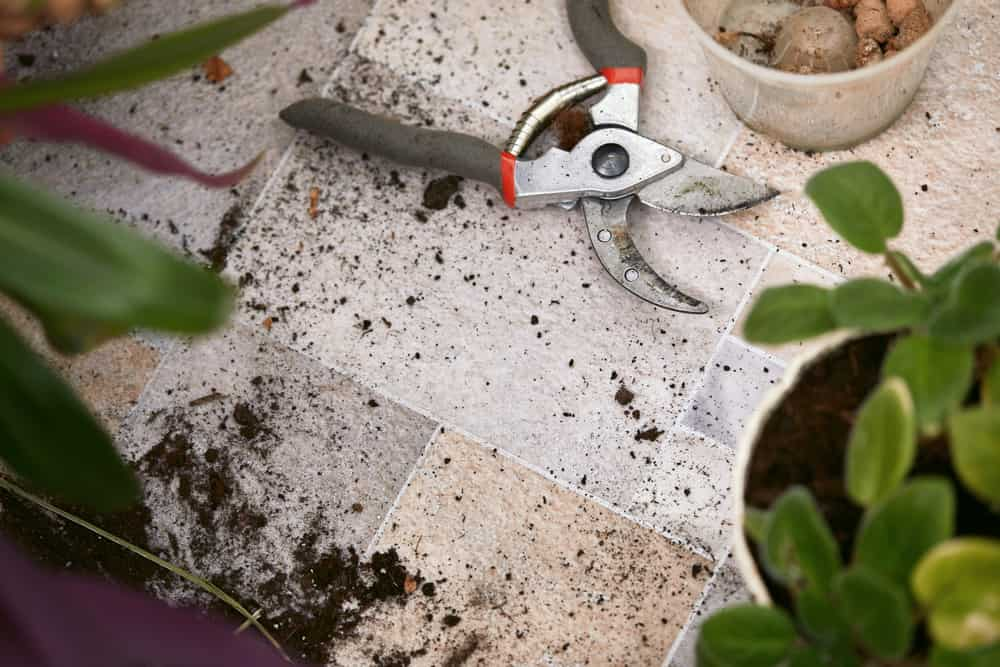Do you have a pothos plant that is growing wild? Are the leaves becoming too long and straggly?
If so, it is time for you to start pruning your pothos!
In this article, we will teach you how to prune your pothos like a pro.

Table of Contents
How to prune pothos
Pruning a pothos is a fairly easy process that you can do to help keep your plant healthy and looking its best. Here are the steps you need to take:
1. Gather materials
First, you’ll want to have everything prepared. This will make the process go much smoother. You’ll need a sharp pair of scissors or pruning shears and something to catch the leaves as you cut them off. A garbage can or bag will work perfectly for this.
2. Sterilize your scissors
You’ll want to sterilize your scissors before you start cutting into the plant. This will help prevent the spread of disease. You can do this by wiping them down with rubbing alcohol or dipping them in boiling water for a few seconds.

3. Cut off sick, yellowing, or brown leaves
Once your scissors are sterilized, you can start cutting off the leaves. Remove leaves that are yellow, brown, wilted, or otherwise damaged. You can also trim back any leaves that are excessively long or straggly.
4. Cut off overcrowded areas of the plant
If there aren’t many sickly leaves, you’ll want to prune the plant by selecting areas that are very filled out. This will stimulate new growth while allowing more light and airflow to reach the plant.
Related: 12 Reasons Why Your Pothos Is Not Growing (and How to Fix It)
5. Dispose of the leaves
After you have cut off all of the leaves you want to, be sure to dispose of them properly. If the leaves have any fungal or bacterial diseases, you don’t want to spread these diseases to other plants. So make sure to either throw them away or burn them.
6. Regularly prune your pothos
Now that you’re done pruning your pothos, be sure to do it on a regular basis. This will ensure that your plant stays healthy, full, and looks its best. Aim to prune it every few months or so.
When should I prune my pothos?
The best time of the year to prune your pothos plant is during the spring, summer, and early fall months. This is because the plant is actively growing during these times and will be able to recover quickly from any pruning you do with minimal stress.
Pruning pothos in winter is possible, if needed, but as this won’t be your pothos’ growing season, you run the risk of creating excessive stress for your plant which can cause longer term damage.

You can also prune your pothos if it becomes overgrown or leggy. This usually happens because the plant is not receiving enough light. So if you notice your pothos starting to stretch out, pruning a leggy pothos is a good idea along with putting it in a brighter location.
If your plant is diseased or infested with pests, you’ll also want to give it a good pruning. This will help get rid of the affected leaves and stems, which will help the plant recover. However, you may need to take additional steps to get rid of the pests or diseases completely.
Many people also prune so as to train their pothos to climb and vine along a trellis or other support. If you want your pothos to climb, simply prune the plant back a few inches from the main stem. This will encourage new growth which will then start to vine along whatever support you have.
What equipment do I need to prune pothos?
To prune pothos, you’ll need something to cut the leaves off with. A sharp pair of scissors or pruning shears will work perfectly for this. You’ll also want something to sterilize the scissors with, such as rubbing alcohol or boiling water.
Finally, you’ll need somewhere to dispose of the leaves when you’re done. You may also want some cleaning supplies handy in case you get some soil or other debris to clean up.
Does trimming pothos make it bushier?
Yes, trimming pothos will make it bushier. This is because when you prune the plant, it stimulates new growth. So if you want your pothos to be fuller and bushier, give it a good trimming. Just be sure not to remove too much all at once so that the plant can recover.
Find out more: 14 Proven Tips to Make a Pothos Fuller and Bushier
Will pothos grow back after cutting?
As long as your pothos plant is healthy and has enough leaves, it will grow back after you cut it. In fact, pruning is a good way to encourage new growth and keep your plant looking its best. You will need to regularly prune your pothos to keep it full and healthy, so don’t be afraid to cut it back.
You can expect new growth to start within a few weeks of pruning. The warmer the weather is, the faster the plant will grow. Watering the pothos enough and making sure that it is occasionally fertilized will also help it to grow back quickly after being pruned.
Your pothos leaves may not grow back if the plant is unhealthy or if you remove all the leaves. So be sure to make sure the plant is in good condition and prune with care.

How much should I prune my pothos?
A general rule of thumb is to remove about one-third of the plant material when you prune. However, you can remove more or less depending on the time of the year, the health of the plant, and your personal preference.
If you are unsure how much to prune, it is always better to err on the side of caution and remove less rather than more. You can always go back and remove more if needed, but you can’t put leaves back once they’ve been cut off.
Over time you’ll get a feel for how much pruning your pothos plant needs and can adjust accordingly.
Should I cut off damaged pothos leaves?
Yes, you should cut off damaged pothos leaves. Damaged, diseased, or stressed plant leaves take a lot of energy to maintain and will only drag the plant down. By removing them, you allow the plant to focus its energy on new growth and recovery.
So if you see any damaged or diseased leaves on your pothos plant, be sure to cut them off. In particular, feel free to trim your pothos’ dead leaves. You can do this as they appear or schedule a regular time to check your plant and remove any damaged leaves.

If a majority of the leaves are damaged, there may be something wrong with the plant that pruning can’t fix. Some potential problems include pests, diseases, too much or too little water, and poor drainage.
If you aren’t sure what’s wrong with your plant, it’s always best to consult with a professional at a local nursery or research the situation online. They can help you diagnose the problem and come up with a plan to get your pothos plant healthy again.
Where do I cut my pothos?
It’s best to prune a pothos plant right below its root node. If you make sure to prune near the crown, which is the area just below the root node, you’ll encourage new stem growth. These stems can grow several new leaves and help to make your pothos plant fuller.
If you’re not sure where the root node is, just look for a small bump or knob on the stem. This is where new growth will emerge, so it’s the ideal place to make your cut.
When pruning pothos, be sure to cut at a 45-degree angle just above the root node. This will help the plant heal quickly and encourage new growth.
Can I propagate the pothos cuttings?
Yes, you can propagate pothos cuttings in water or soil. To do this, simply cut a piece of the plant that is about six inches long and has at least two leaves. Remove the bottom leaf so that you’re left with one leaf on the cutting.
You can then place the pothos cutting in a glass of water or pot of soil. It’s not necessary, but you can use rooting hormone to help encourage growth.
Related: 8 Simple Steps to Propagate Pothos Plants Successfully
Make sure to change the water every few days or keep the soil moist but not wet. You should see new roots start to grow within a few weeks. Once the roots are an inch or two long, you can transplant the cutting into a pot of its own.
Can you keep pothos in water forever?
Pothos plants can technically stay in the water forever if they’re well cared for. This includes changing the water regularly, using filtered or distilled water, and keeping the plant out of direct sunlight. Regular fertilizer can also help to keep a pothos plant healthy in water.
However, most people choose to eventually transplant their pothos plants into soil even if you start by having pothos grow in water. This is because it’s easier to control the plant’s environment and provide the nutrients it needs when it’s in soil. It will require less maintenance, since this is an overall easy plant to take care of when potted.

How do you find a node on a plant?
A node is typically a small, raised area on a plant stem. It’s often where leaves or flowers emerge from the stem. If you’re not sure where the node is, just look for a small bump or knob on the stem. This is usually where the node is located.
How do you tell if a node is spent?
A spent node is a node that has already produced leaves or pothos flowers and is no longer active. You can usually tell if a node is spent because it will be dry and brown. If you’re not sure whether a node is spent, you can gently scrape it with your fingernail. If it’s green underneath, then it’s still active.
What is the difference between node and stem?
A node is a small, raised area on a plant stem. It’s often where leaves or flowers emerge from the stem. A stem is the main body of the plant that typically extends above ground. Leaves and flowers grow from nodes that extend along the stem.
Related: Pothos Nodes: The Ultimate Guide to Getting Them to Grow
Do pothos ever branch?
Your pothos plant will branch if you encourage it to. You can do this by pinching back the stems or by cutting them just below a node. This will encourage the plant to produce new growth from that point, which will typically result in branching.
If you notice that your plant is not branching, it may be due to a lack of nutrients. Try using a fertilizer specifically made for pothos plants and see if that helps encourage new growth.
